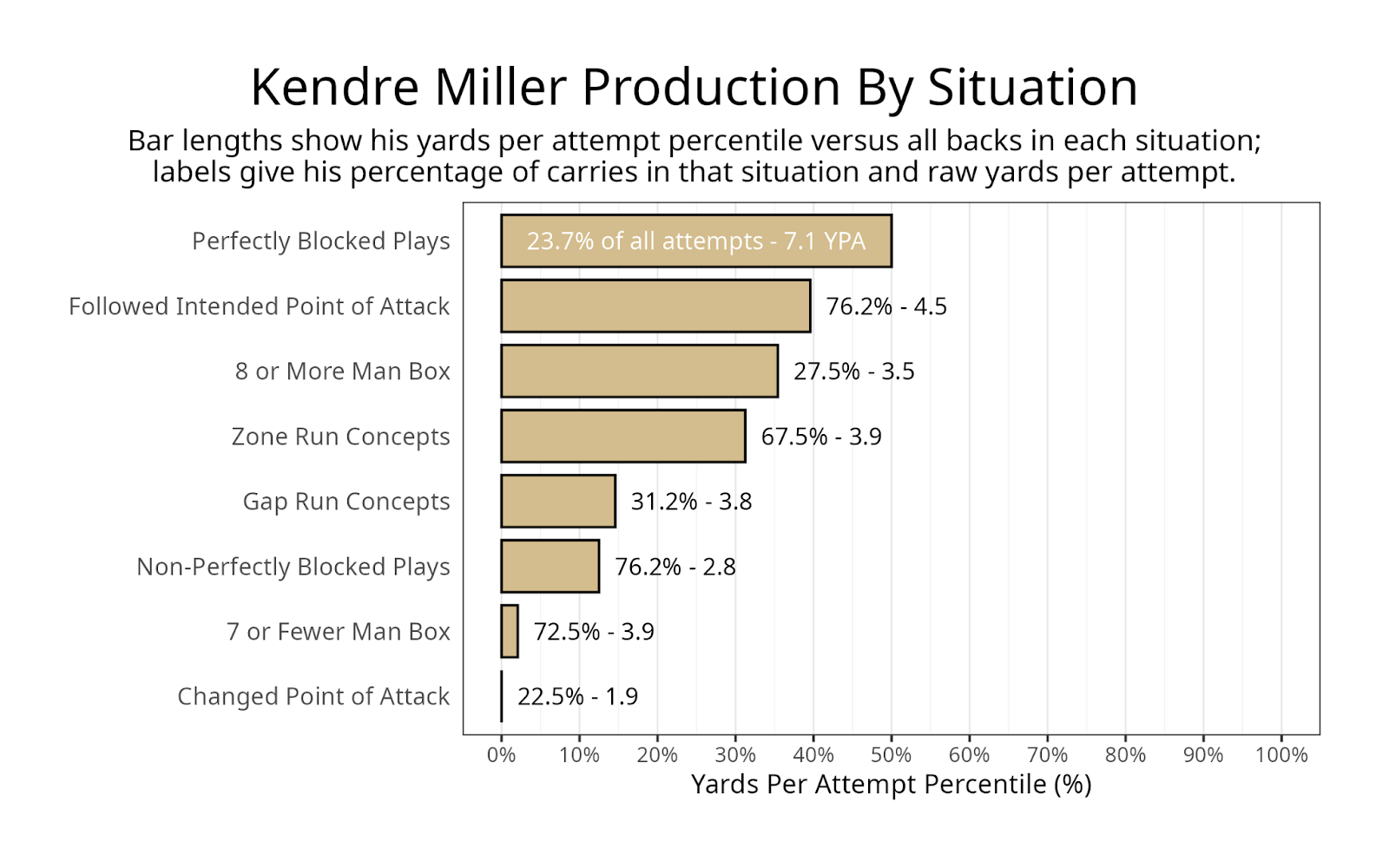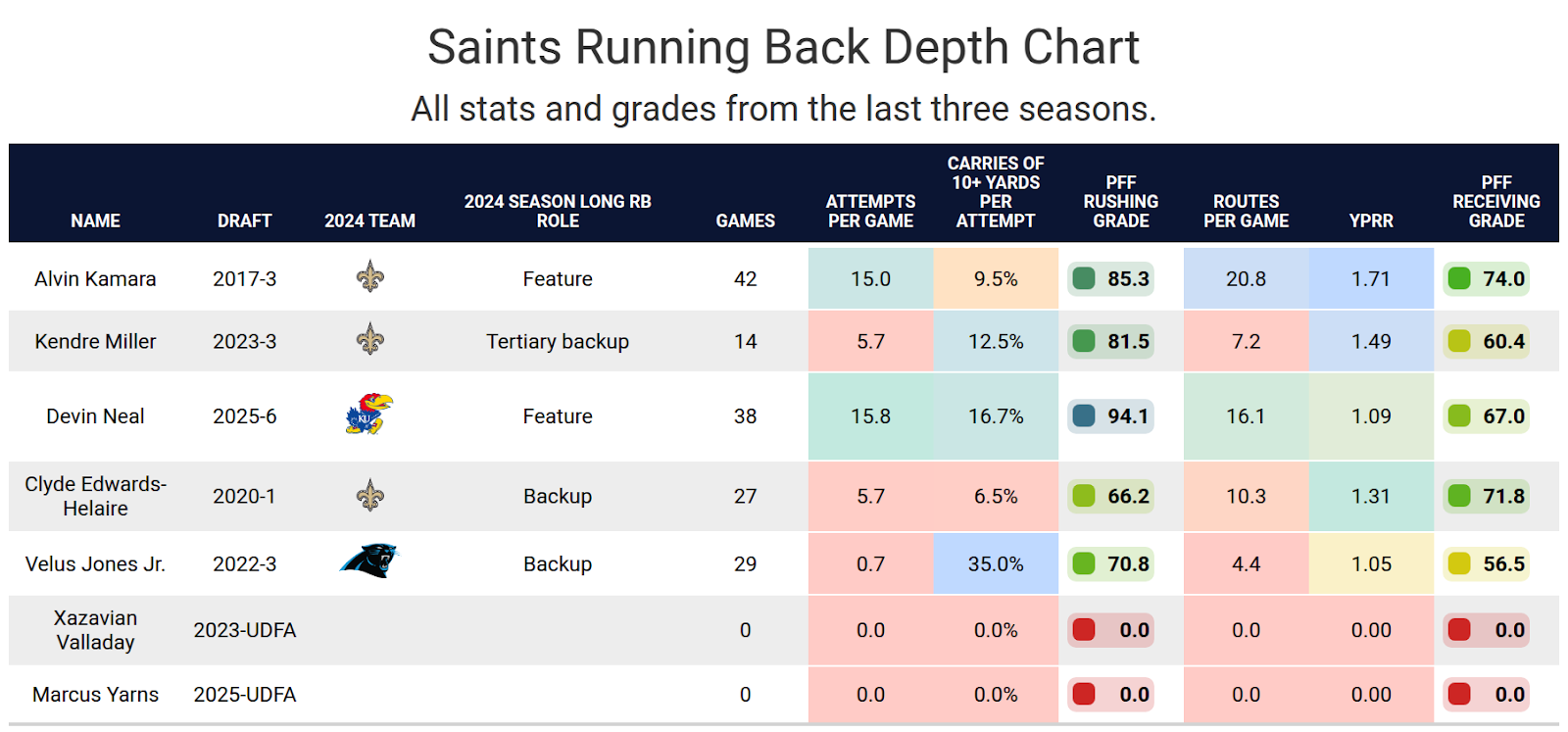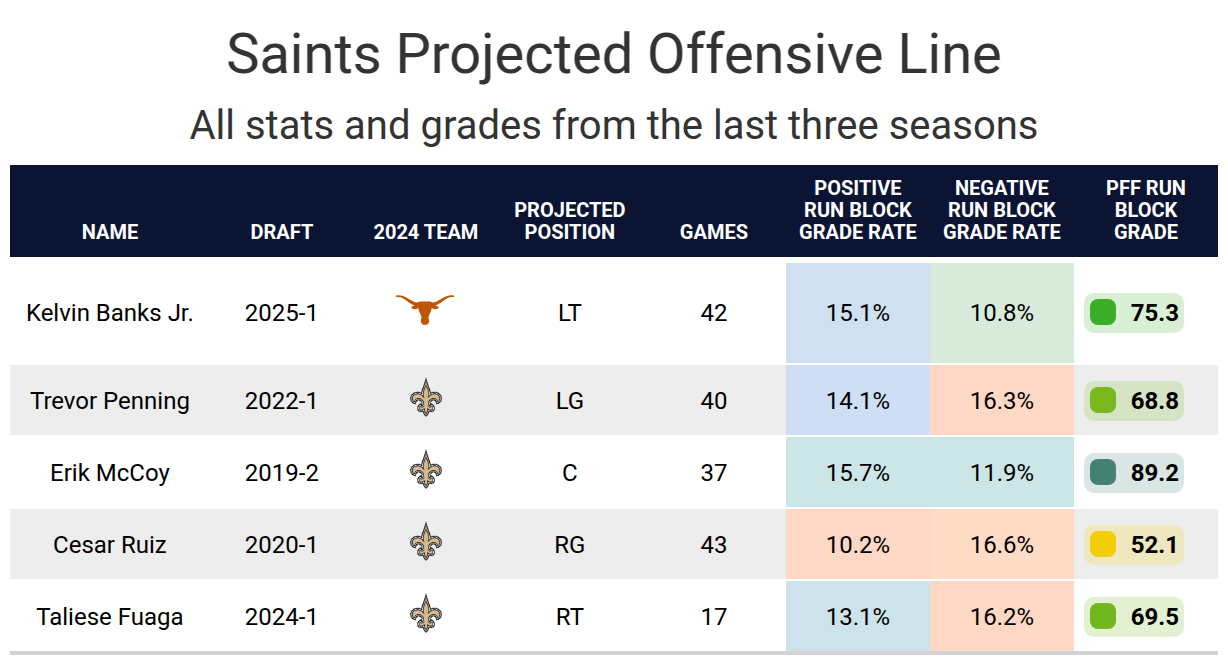- Injury-riddled start: Kendre Miller‘s early NFL career with the New Orleans Saints was marked by several injuries, limiting his on-field time despite showing strong per-play potential when healthy.
- Potential Breakout Year: Looking to 2025, Miller has an opportunity to carve out a more significant role in the Saints' offense. There is a possibility he competes for carries alongside Alvin Kamara and capitalizes on an improved offensive line.
- Subscribe to PFF+: Get access to player grades, PFF Premium Stats, fantasy football rankings, all of the PFF fantasy draft research tools and more!
Estimated Reading Time: 5 minutes

PFF’s Fantasy Football Player Profile series delivers the most in-depth fantasy football analysis available for the 2025 season.
Using PFF’s exclusive data, we evaluate player performance, competition for touches and how teammates and coaching staffs
Last updated: 7:15 a.m. Friday, June 13
Player performance
The New Orleans Saints spent a few years giving Alvin Kamara minimal competition for snaps out of the backfield. The Saints tried to change that in 2023 by adding Jamaal Williams in free agency and Kendre Miller with the 71st pick of the draft. Miller didn’t participate in pre-draft workouts due to an MCL injury, then he dealt with a knee injury and a hamstring injury before the start of the 2023 season.
He made his regular-season debut in Week 3, as Kamara was dealing with a suspension and Williams was out due to an injury. This led Miller to lead the team in carries at nine, culminating in 34 yards. He barely played in Week 4 but received 12 carries for 37 yards in the Saints' blowout win in Week 5. Williams returned from injury, leading Miller to barely play in Weeks 6-9. Miller suffered an ankle injury that cost him seven games. He returned in Week 18, where he ran 13 times for 73 yards and a touchdown in another blowout victory.
A hamstring injury cost Miller all of his 2024 training camp and the first five games of the season. He played 20 snaps in Week 7 and another 10 in Week 8 before another hamstring injury to his other leg cost him another four games. The Saints made Miller a big part of the offense upon his return. Miller ran 10 times for 32 yards and a touchdown in his first week back. Kamara suffered an injury in his second game back, where he ran nine times for 46 yards. He started the following two weeks but suffered a concussion in Week 17, costing him Week 18.
Miller’s per-game stats have not been great, as he’s primarily been a backup and has left several games early. However, his per-play numbers in both the run and pass game are relatively strong. Both his avoided tackles per rushing attempt and yards per route run rank among the top six among running backs over the last two seasons.
It’s worth noting that Miller is relatively young for a running back despite his experience. He will be 23 before the start of the season, making him younger than several rookie running backs, including second-round pick R.J. Harvey.



Projected role
The Saints moved on from Jamaal Williams but added Clyde Edwards-Helaire late last season, and drafted Devin Neal in the sixth round of the draft. Miller is most likely to win the backup job if he can stay healthy. Miller is the biggest running back of the four. He’s played at a high rate on short yardage over the last two seasons. There is at least a chance he can take some of the goal-line work.
There is no guarantee Miller wins the backup job. The Saints have a new coaching staff, and that new staff decided to draft Neal and bring back Edwards-Helaire. However, there is also a chance Miller could earn some playing time from Kamara. Miller’s rushing grade is slightly better than Kamara’s over the last two seasons. The two have identical yards per carry, as Miller has more yards after contact per attempt and twice as many avoided tackles per run. Miller has a slightly higher first-down rate. There is a seven-year age gap between Kamara and Miller, and Miller is more likely to improve while Kamara is more likely to decline. It’s certainly possible Miller can pull even with Kamara on early downs, even if Kamara remains the receiving back.


Impact of teammates
The Saints added Kellen Moore as their new head coach. Moore’s offenses have generally had a high play count, allowing them to rank above average in run attempts, but a low rate of targeting running backs. He’s had multiple top-10 fantasy running backs with Ezekiel Elliott and Tony Pollard with the Dallas Cowboys and Saquon Barkley last season with the Philadelphia Eagles. While Moore has generally used a veteran running back as his lead back, in 2022, Pollard cut significantly into Elliott’s playing time, and Miller could similarly cut into Kamara’s playing time. On the bright side, Moore has said Miller gets a fresh slate to move on from his injury history and past with the previous coaching staff. However, Moore has spoken glowingly of Kamara.
The Saints had a top-10 run-blocking offensive line last season because the team constantly prioritized the line from the NFL draft. Center Erik McCoy was a clear strong point with an elite 94.6 run-blocking grade, but he was only able to play seven games. The team moved on from their oldest veteran, Lucas Patrick, in favor of Kelvin Banks Jr., New Orleans' first-round rookie. Considering all of the injuries to the interior parts of the line, there is a chance the line could rank even higher than the top 10 this season. Miller averages 7.1 yards per carry on perfectly blocked runs compared to 2.8 on non-perfectly blocked runs. Miller should see a higher rate of perfectly blocked runs this year, helping his performance.


Bottom line
Kendre Miller is more high-risk, high-reward than the usual running back. There is at least a possibility Miller can lead the team in rushing yards even if Alvin Kamara stays healthy the entire season. However, Miller also has an extensive injury history over a short NFL career, and it’s possible someone else wins the backup job in New Orleans.

Footnotes
- Statistics in tables and charts were chosen based on their ability to predict future fantasy performance on a per-game or per-opportunity basis or to describe the player relative to others at the same position.
- “Opportunities” are defined as passing dropbacks, rushing attempts and routes run as a receiver.
- Numbers are provided either by season or based on the past three years. For rookies, only college statistics are included. For non-rookies, only NFL statistics are considered, regardless of whether they played in college within the previous three years.
- As college competition is easier than NFL competition, most rookies are likely to see a decline from their historical numbers.
- Only FBS data is considered for college players and comparisons.
- Kneel-downs are removed from rushing data to provide cleaner quarterback rushing rate statistics.
- The table colors in this article range from blue (indicating good/high) to red (indicating bad/low).
- All percentiles and color codings compare the given player to others with a high sample of opportunities. Generally, the cutoff is one-third of the possible opportunities in the sample. If a player does not meet the threshold, they are still included in the comparison, though their results may appear better or worse than expected due to the smaller, less predictive sample size.
- Information on utilization classifications and their importance can be found here for running backs, wide receivers and tight ends.



 © 2025 PFF - all rights reserved.
© 2025 PFF - all rights reserved.